
Tulip (Latin: Tulipa) is a genus of bulbous perennials of the Lily family, one of the most popular spring garden plants, grown both in private gardens and on an industrial scale. The birthplace of tulips is Central Asia, and the plant got its name from the Persian word “turban”, the shape of which resembles a flower.
Features
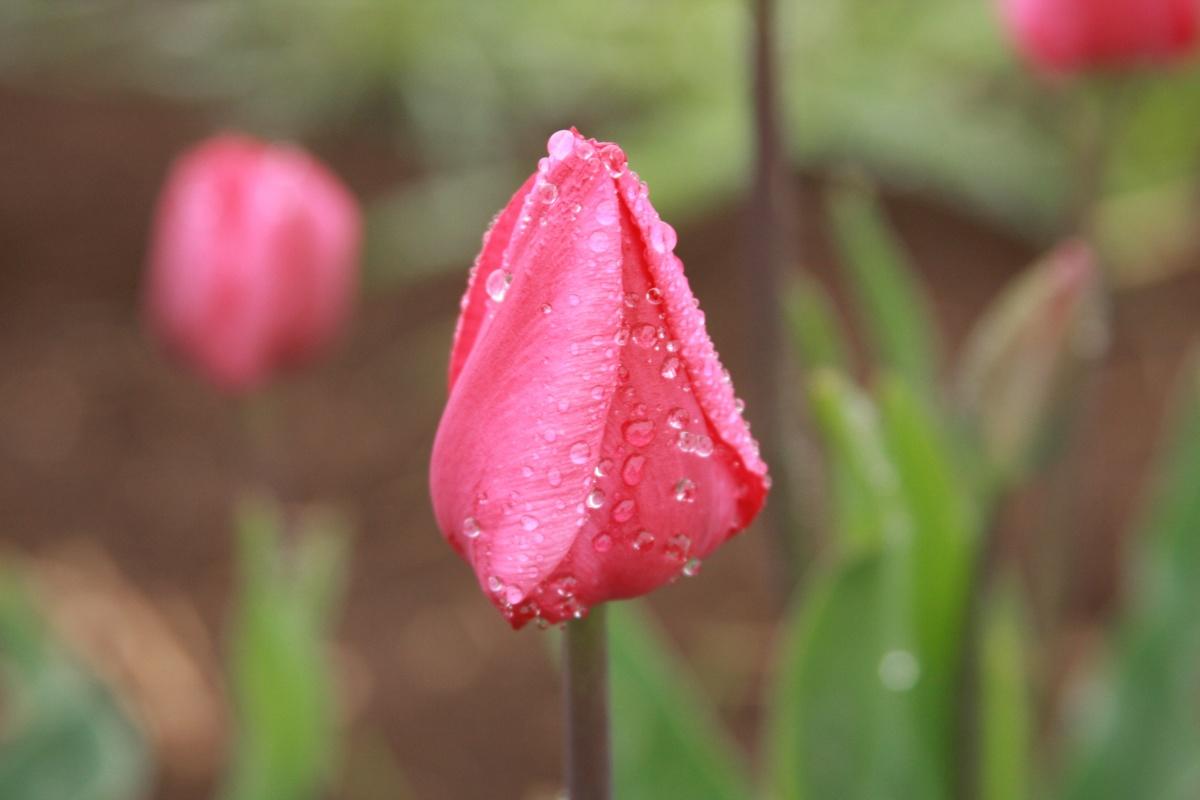
The tulip grows to a height of 10 cm (4 inch) to a meter (3.2 ft). The root system consists of adventitious roots that grow from the bottom of the bulb and die off annually. Young bulbs form hollow stolons-side shoots growing sideways or vertically downwards, at the bottom of the stolons a daughter bulb is formed. The stem of the tulip is cylindrical, erect, the leaves are bluish-green due to a light waxy coating, elongated-lanceolate, arranged along the stem alternately. The largest sheet is the lower one, and the smallest (flag sheet) is the upper one. The flowers of tulips open in the sun and close at night or in cloudy weather.
The flower of a tulip is usually one, although there are species and varieties of multi-flowered, with 3-5 flowers or more. The flowers are regular, the perianth consists of six leaflets, six stamens with elongated anthers, most often the tulip flower is red, less often-yellow, even less often-white. The color of varietal tulips is much more diverse: red, purple, pure white, yellow, purple and almost black, there are varieties that combine several colors in the most incredible variations.

The shape of the tulip flowers is also diverse: cup-shaped, goblet-shaped, lily-shaped, oval, peony-shaped, star-shaped, fringed… The size of the flower also depends on the variety – sometimes the length is 12 cm (4.7 inch), and the diameter is from 3 to 10 cm (1-4 inch) (in full disclosure up to 20 cm (8 inch)). The fruit of tulips is a triangular box, the seeds in it are triangular, flat, yellow-brown.
Planting Features
In order for the cultivation of tulips and their care to be joyful and productive, it is necessary to remember the rules of agricultural technology for these flowers.
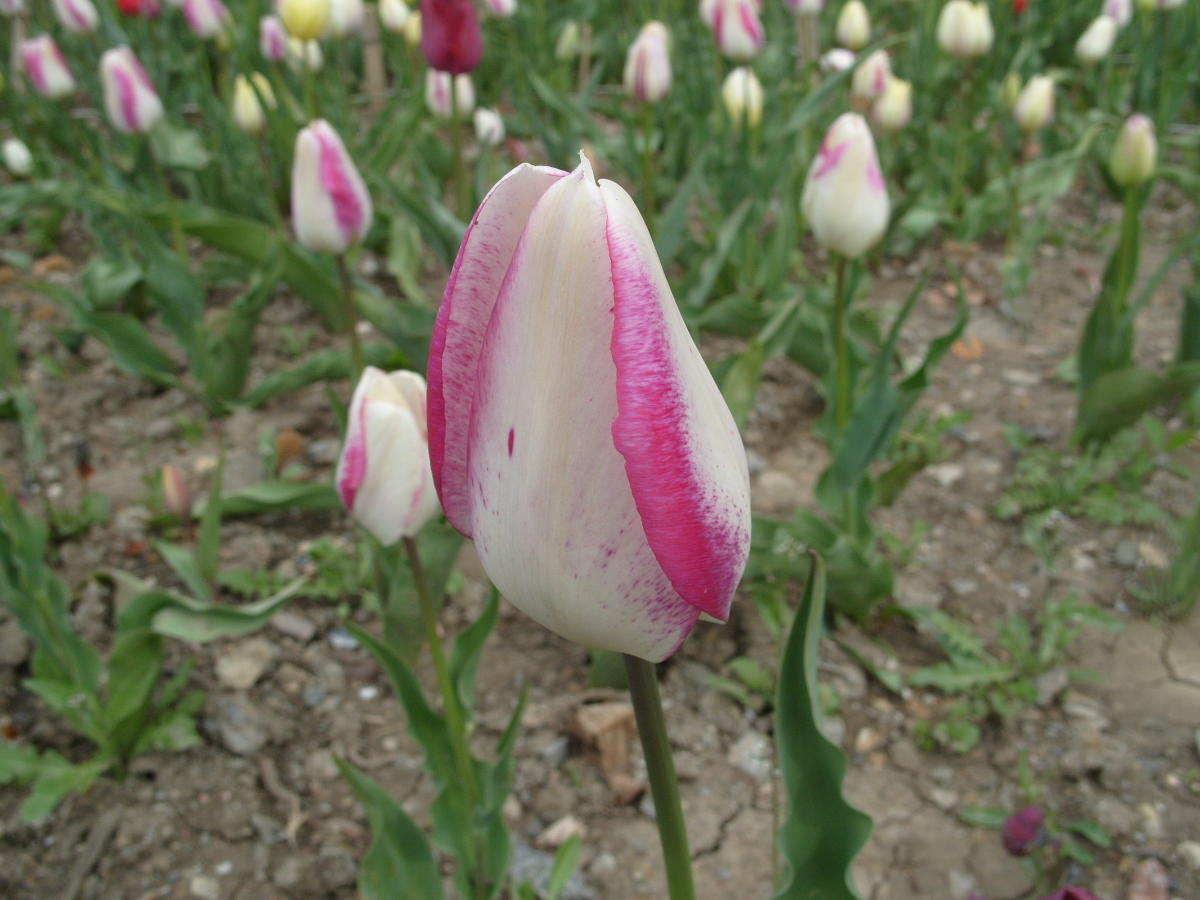
There are a number of features that you need to know if you decide that the care of tulips is worth your effort: during the growing season, tulips are fed at least three times;
the appearance of tulips indicates what kind of fertilizer they need: if the leaves have become narrow and do not maintain an upright position, it means that they do not have enough nitrogen, and if the edges of the leaves appear blue, it means that the tulips lack phosphorus and potassium;
in the spring, it is necessary to remove sick plants together with the bulb, roots and a lump of earth, and a hole for disinfection pour boiling solution of potassium permanganate;
the cultivation of the land around the plants should be carried out very carefully, so as not to damage the roots and leaves of the flowers and not deprive the bulb of nutrition;
if you want the tulips to bloom in large flowers next year, and the bulb does not break up into small bulbs, remove the withered flower before the formation of a seed capsule;
tulip bulbs do not tolerate direct sunlight, so they need to be dried in the shade; do not apply fresh manure as fertilizer, this contributes to the rotting of the bulbs and exposes the tulips to the risk of fungal diseases;
in low-snow and cold winters, tulips need mulching with humus, peat, straw or sawdust;
when cutting tulips, leave 2-3 leaves on the plant so that the bulb can eat and develop normally;
on the site where you decided to plant tulips, they should not have grown for at least three years before.
Planting in an Open Area
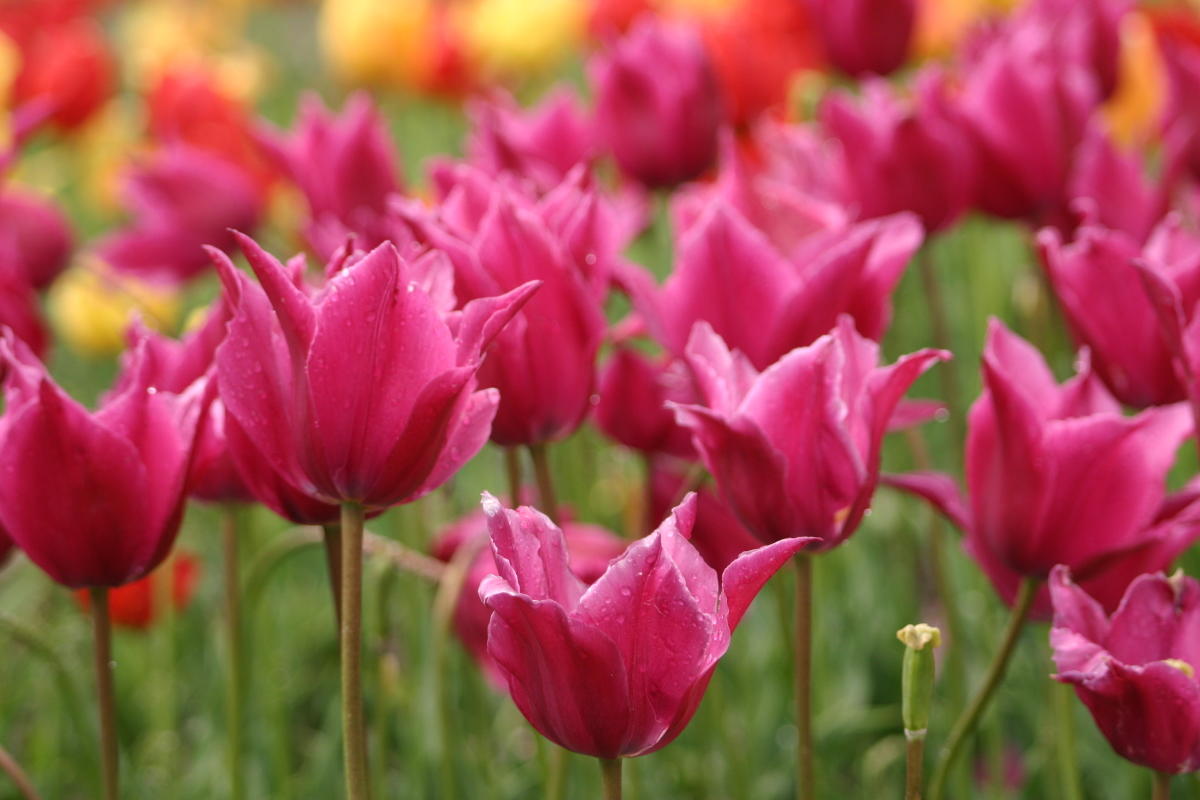
It is very important to choose the optimal time. Planting of tulips is carried out in the fall, and it should be borne in mind that they will need 3-4 weeks to take root. Late-planted tulips in the spring will lag behind in growth and give small bulbs, and the flowering will not be so decorative. Too early planting can cause flowers to sprout in the fall, and the onset of frost can destroy them. The best time for planting is determined by the soil temperature at a depth of 10-12 cm (4 inch): when it reaches +10°C (50°F) – it is time to plant tulips. This usually happens in mid-September.
Planting in Spring
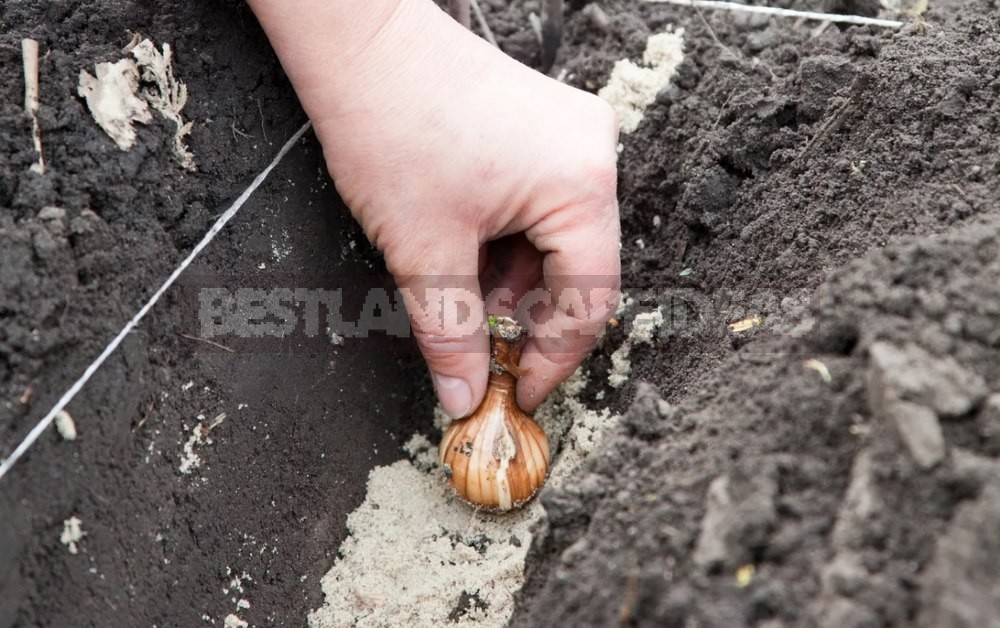
Experienced flower growers say that you can plant tulips in the spring, if for some reason it did not work out in the fall, but then do not count on a lush flowering: at best, only a few specimens will bloom this year. Before planting, the bulbs should be kept overnight in the refrigerator, and then etched in a weak solution of potassium permanganate for half an hour. As soon as it gets warmer, prepare the bed: dig the soil with a pitchfork and make grooves at a distance of 25-30 cm (11 inch) for large bulbs and 10-15 cm (4-6 inch) for smaller specimens, and just before planting, carefully pour the grooves with a hot solution of potassium permanganate.
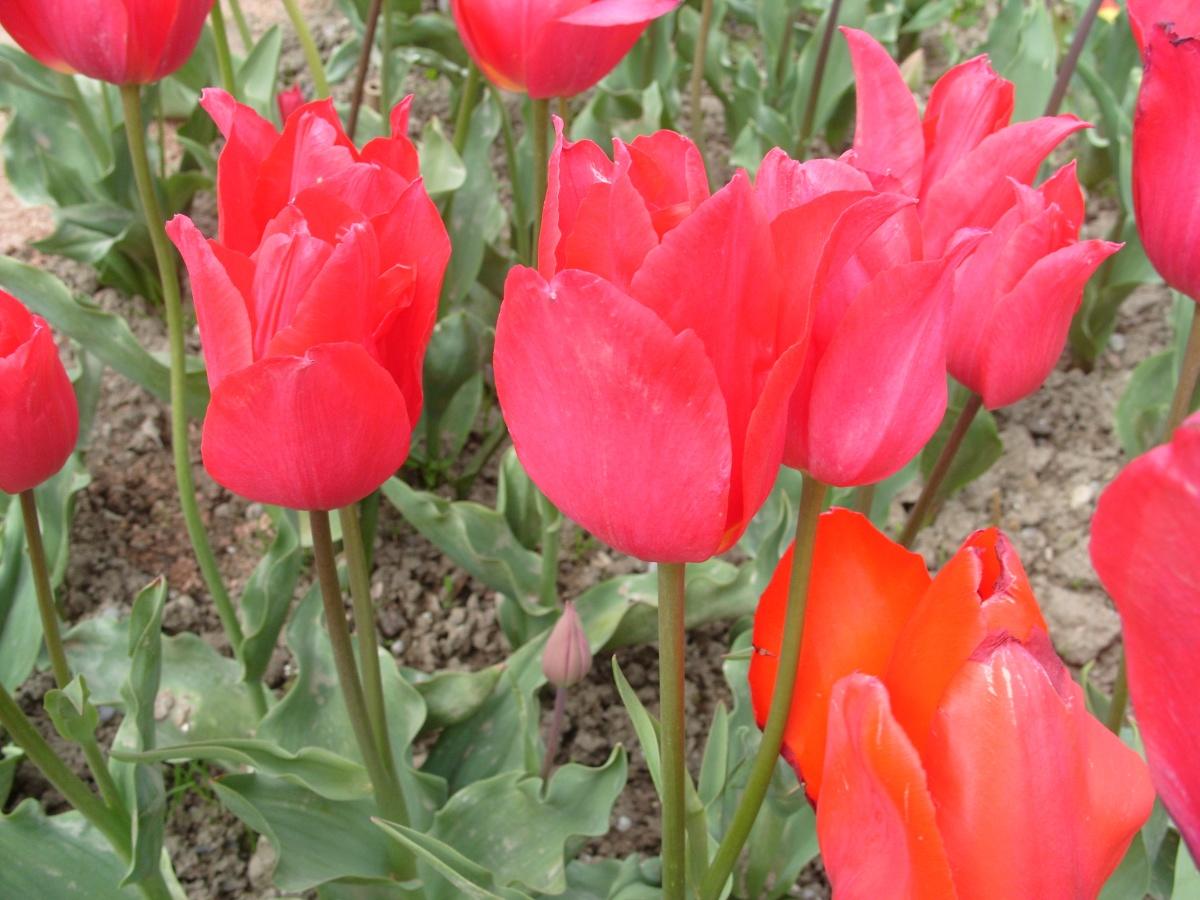
The area for tulips should be well-lit, drained and protected from strong winds. The soil should best be neutral or slightly alkaline, sandy loam with the introduction of rotted compost and wood ash (200g per m2 (7 oz per 3.2 ft)). Heavy soil can be improved by adding river sand, compost, and loose, fertile soil. Drainage can be strengthened by filling the bottom of the furrow with large washed sand in a three-centimeter (1 inch) layer. Bury large bulbs in the ground for 10-15 cm (4-6 inch), and small bulbs-for 5-7 cm (2.3 inch), slightly pressing them into the soil, fill the bulbs with earth and bury them with a rake. It is advisable to mulch the area with peat in order to avoid cracking of the soil.
Planting in Autumn

Proper planting and care of tulips in autumn is very important, because they are waiting for low temperatures, and how you cope with the task depends on the quality of flowering tulips next year.
Before planting, the bulbs are examined, sick and damaged ones are selected and destroyed, so that they do not infect healthy specimens and the soil. It is better to plant tulips by varieties, because in this case it is easier to care for them, and it is more convenient to dig them out. Etch the bulbs before planting in the ground in a five-percent solution of potassium permanganate for 30-60 minutes and plant as described in the previous chapter. The depth of planting depends on the size of the bulb: in light soil, the depth of planting is equal to three diameters of the bulb, and in heavy soil-two diameters. Do not forget to mulch the area with dry leaves, peat, sawdust or straw.
Care for Tulips
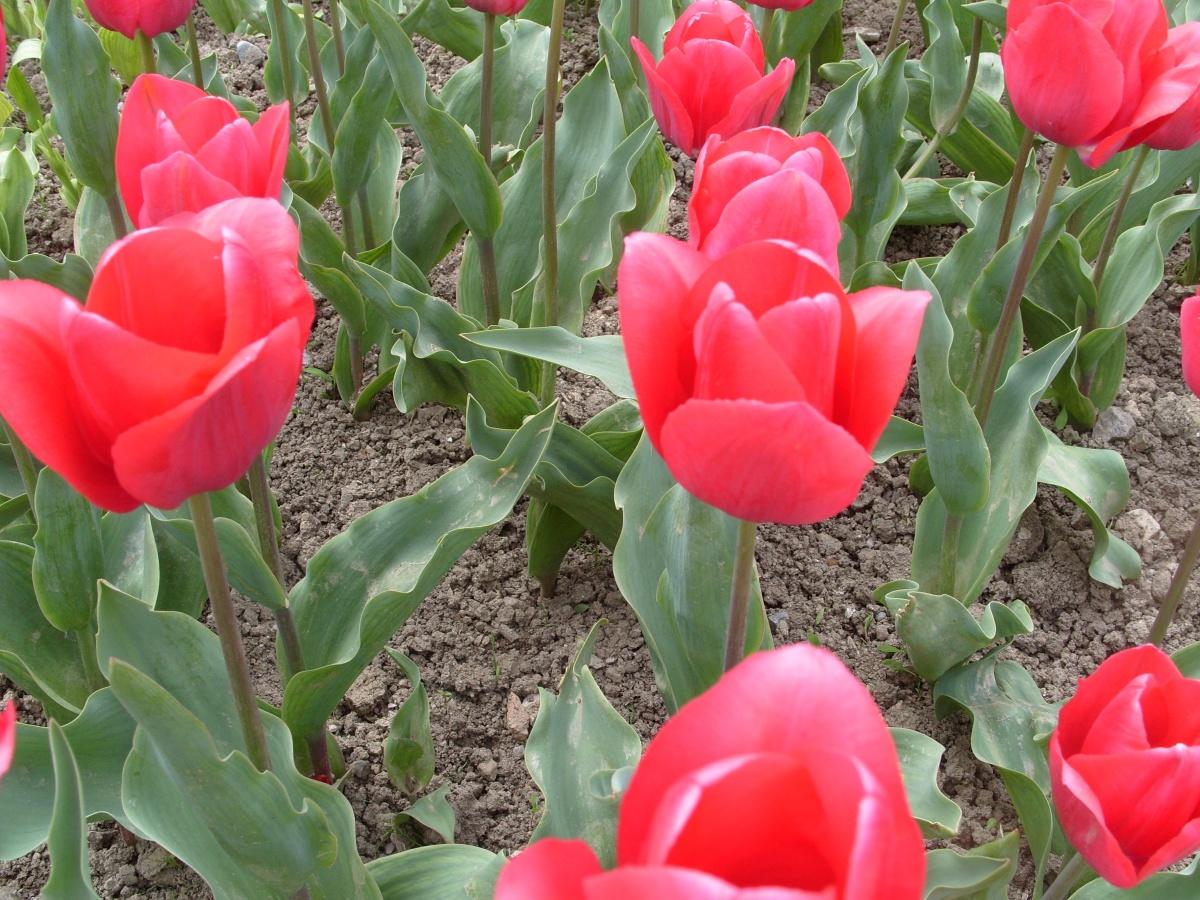
This event begins in early spring, when their red sprouts are just showing up from under the ground: remove the bulbs of ungrown plants and destroy them so that other tulips do not get sick. The tulip is a moisture-loving plant, but due to the structure of the root system, it is unable to extract moisture from the deep layers of the earth, so timely watering of tulips is the most important condition for their agricultural technology. The frequency and abundance of watering depends primarily on the composition of the soil, but during budding and flowering, watering should in any case be both abundant and regular. By the way, abundant and regular watering should remain for another two weeks after the end of the flowering period. Moisture must penetrate the entire depth of the roots, so on average you need to pour from 10 to 40 liters of water per 1 m2 (2.6-10.5 gal per 3.2 ft2), and in such a way that to avoid burns, water does not fall on the leaves.
Top Dressing
It is better to use the fertilizer with cocktails, but if for some reason you prefer dry fertilizing, then take note: when spreading dry fertilizer, you need to make sure that the leaves of the tulips are dry, otherwise they can cause burns. In addition, after dry feeding, you need to water the area with tulips abundantly, so that the fertilizers, along with moisture, penetrate into the soil and nourish the roots. The first top dressing of tulips is carried out in early spring, as soon as sprouts appear above the ground: you can scatter dry top dressing (nitrogen, phosphorus, potassium in a ratio of 2:2:1) on the site at the rate of 50 g/m2 (1.75 oz/3.2 ft2), followed by watering.

The second time the tulips are fed when the buds begin to appear, and this time it is better to use a cocktail in which the dose of nitrogen decreases, and the content of potassium and phosphorus increases (1:2:2). The third time the tulips are fed immediately after flowering, but only with potassium and phosphorus in a ratio of 1:1 at the rate of 30-35 g/m2 (1 oz/3.2 ft2) (as with the second feeding). If you want to enhance the development of the daughter bulbs, add a little boron and zinc to the cocktail.
Weeding and loosening of the soil on the site with tulips should be carried out regularly, it is most convenient to do this after watering, when the soil is wet, and weeds are easily removed. Weeds deplete the soil and take away nutrients from it, so the fight against them is mandatory. Loosening of the soil contributes to the preservation of moisture in the soil and the death of weeds. Mulching the soil can save you from weeding and loosening.
Well, do not forget to remove the wilted flowers (in scientific terms, this is called “decapitation”), so that the plant does not spend energy on growing seeds that will not be useful to you, instead of helping to increase the mass of the bulb.
Replanting
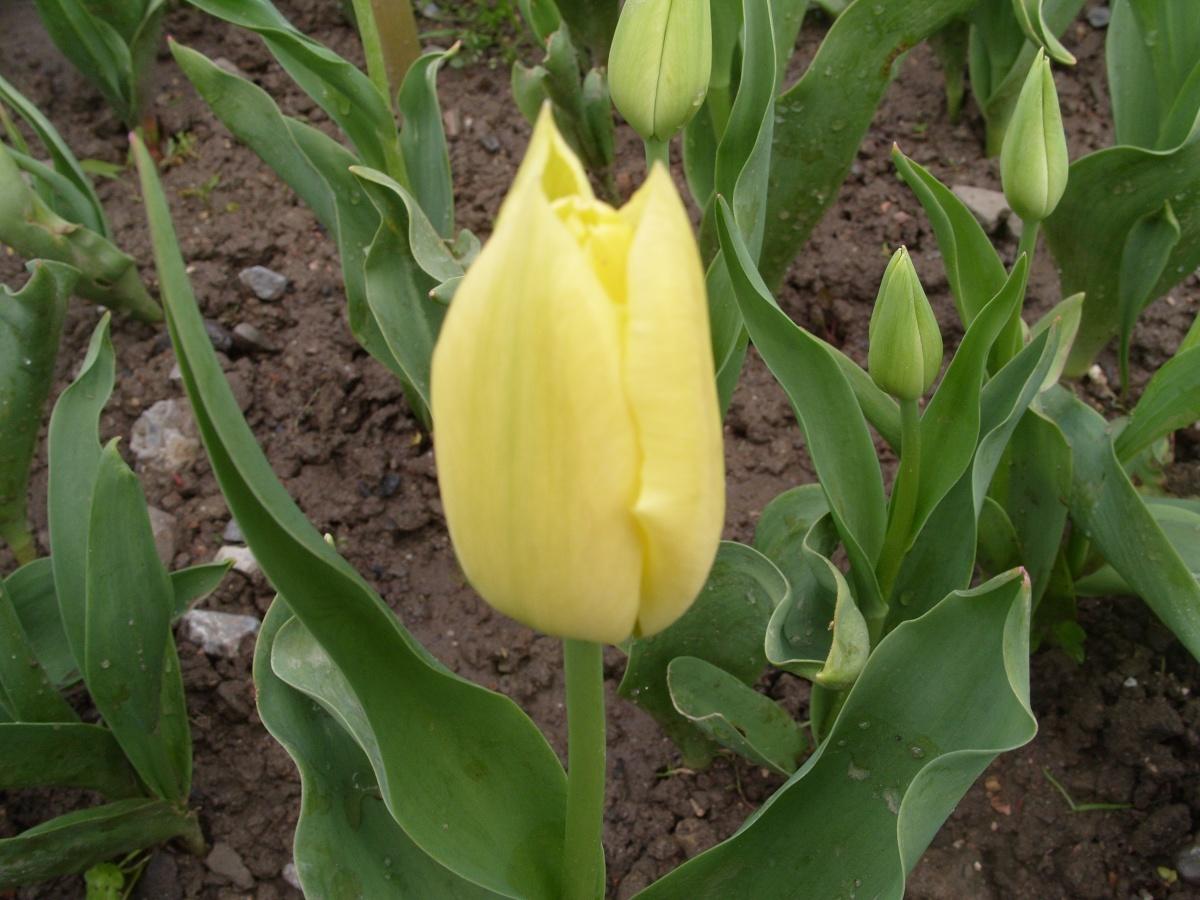
Even if you dig up, sort, and pickle tulip bulbs every year to reduce the risk of disease, it still won’t reduce the negative impact of monoculture to zero. Therefore, you have two options: changing the soil on a permanent site with tulips or transplanting tulips to another site. The best option is the second one. Only class 13, 14 and 15 tulips can grow on one plot without transplanting, but only for 3-4 years, then they will still have to be dug up and transplanted.
Reproduction
Tulips are multiplied by seeds and vegetatively by using daughter bulbs. Seed propagation is used only by breeders, since daughter plants do not retain the varietal differences of their parents. Seeds are sown directly in the open ground or in greenhouses and grow them for two or three years in one place, protecting the seedlings from the winter cold, then the ripe bulbs are dug up, stored until autumn and planted as usual. Such tulips will bloom only in five or six years, but the flowers will be inconspicuous, and only in the eighth or twelfth year, the tulips grown by seed method reach the peak of decorativeness.
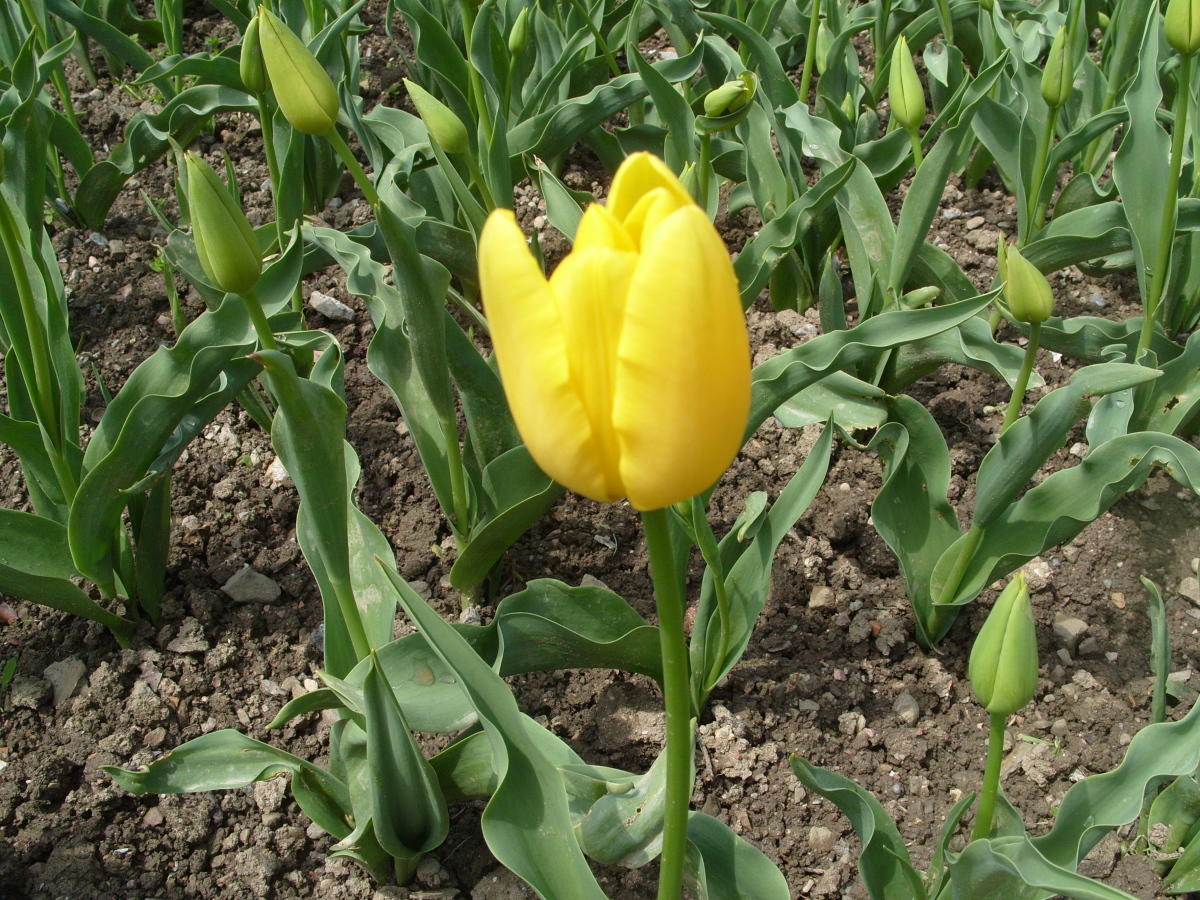
Also, the reproduction of tulips by using daughter bulbs gives good results much faster. The peculiarity of tulips is that their mother bulb dies after flowering, and in its place develops a replacement (daughter) bulb with several small bulbs, the number of which depends on many factors, primarily environmental. Sometimes, instead of one large one, two replacement bulbs are formed, and small options develop so much after a few years that they can form flower stalks themselves.
If you do not want your tulips to degenerate over time, use only topper bulbs with a circumference of 12 cm (4.7 inch) or more for planting in the ground, since they inherit all the necessary characteristics of the variety. Smaller bulbs can be used for forcing at home, and small options must be grown to the size of bulbs-toppers, and only then planted on the site with tulips.
Diseases and Pests
The greatest danger for tulips is the variegated virus, which manifests itself in the form of strokes, spots and stripes on the petals and leaves that are uncharacteristic for monophonic varieties. It is impossible to fight the virus, so buy bulbs only from reliable sellers, and when cutting plants, disinfect the tool after each flower, so that the juice does not transmit the virus to other specimens. Infected plants must be dug up together with a lump of earth and burned. Fill the pit with a strong cocktail of potassium permanganate.
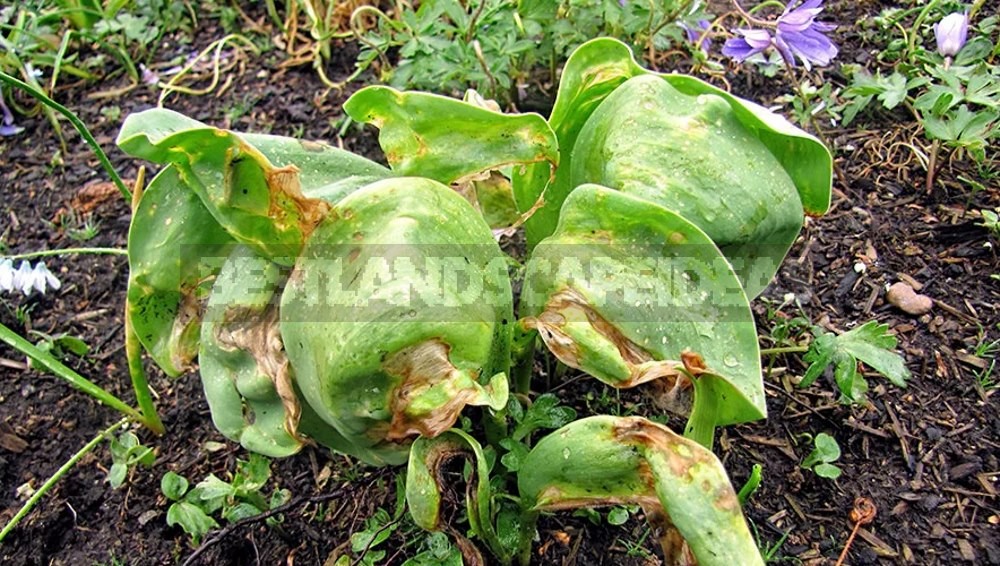
Tulips are affected by the August disease caused by the tobacco necrosis virus. The disease is fungal, manifests itself in the form of a curvature of the stem and an ugly streak of the flower, as well as dark spots on the bulb. The diseased plants should be removed immediately, the well should be spilled with a strong hot cocktail of potassium permanganate and boric acid at the rate of 10 g (0.35 oz) of manganese and 3 g (0.1 oz) of boric acid per 1 liter (0.26 gal) of water. You can also fill the hole with ash. The remaining plants need to be sprayed with a two-percent cocktail containing systemic fungicide.
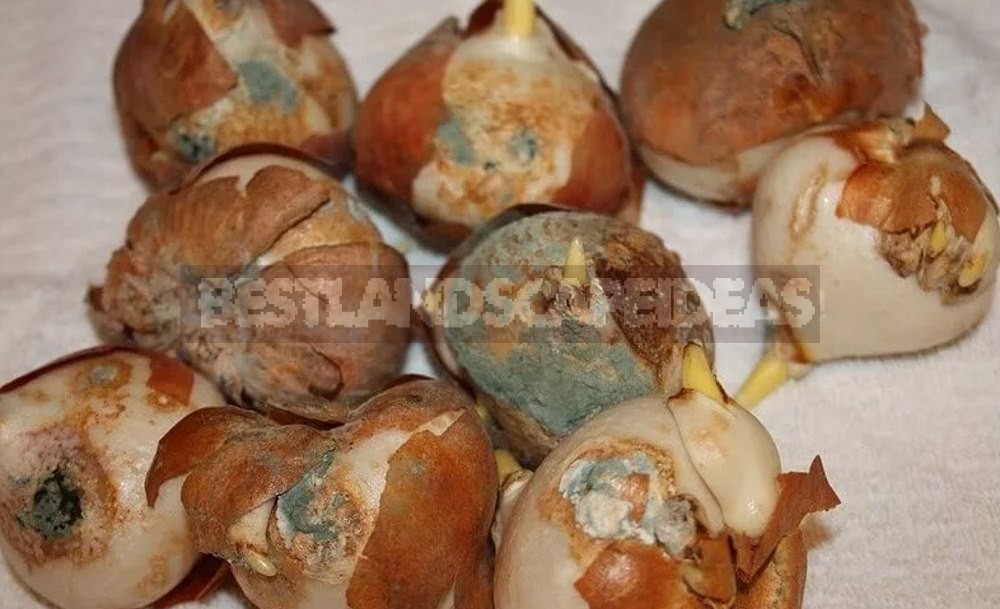
Sometimes tulips suffer from fungal diseases-root or botrytic rot, especially if the spring was wet and rainy. The reasons may be different, but the preventive measures are the same: ensure good soil drainage, follow all the agrotechnical requirements for growing tulips, after the summer digging of the bulbs before their autumn planting, sow plants that secrete phytoncides (marigolds, calendula, mustard, nasturtium) on the site. In addition, for prevention purposes, fungicides are used, watering the site with a cocktail of 20 g per 10 liters (0.7 oz per 2.6 gal) of water.
Among the pests dangerous to tulips are purple scoops, root onion mites, snails, slugs and mouse-like rodents.

Against the onion mite, heat treatment of the bulbs is used, lowering them for five minutes in hot (35-40°C – 95-104°F) water. If the infection is detected already during the growing season, the tulips are sprayed with a two-percent solution of Rogor, and if this does not give quick results, it is necessary to dig up the sick specimens and destroy them. After digging up the bulbs from the plot, plant tomatoes, radishes or tagetes on it – these plants are resistant to mites.
In order to fight off snails and slugs, throw traps around the site: rags, pieces of plywood or slate, under which they like to crawl, and every day collect insects and destroy them.
As for rodents, you will have to arrange mousetraps or dust the bulbs of tulips with various plant anticores before planting.
Care After Flowering
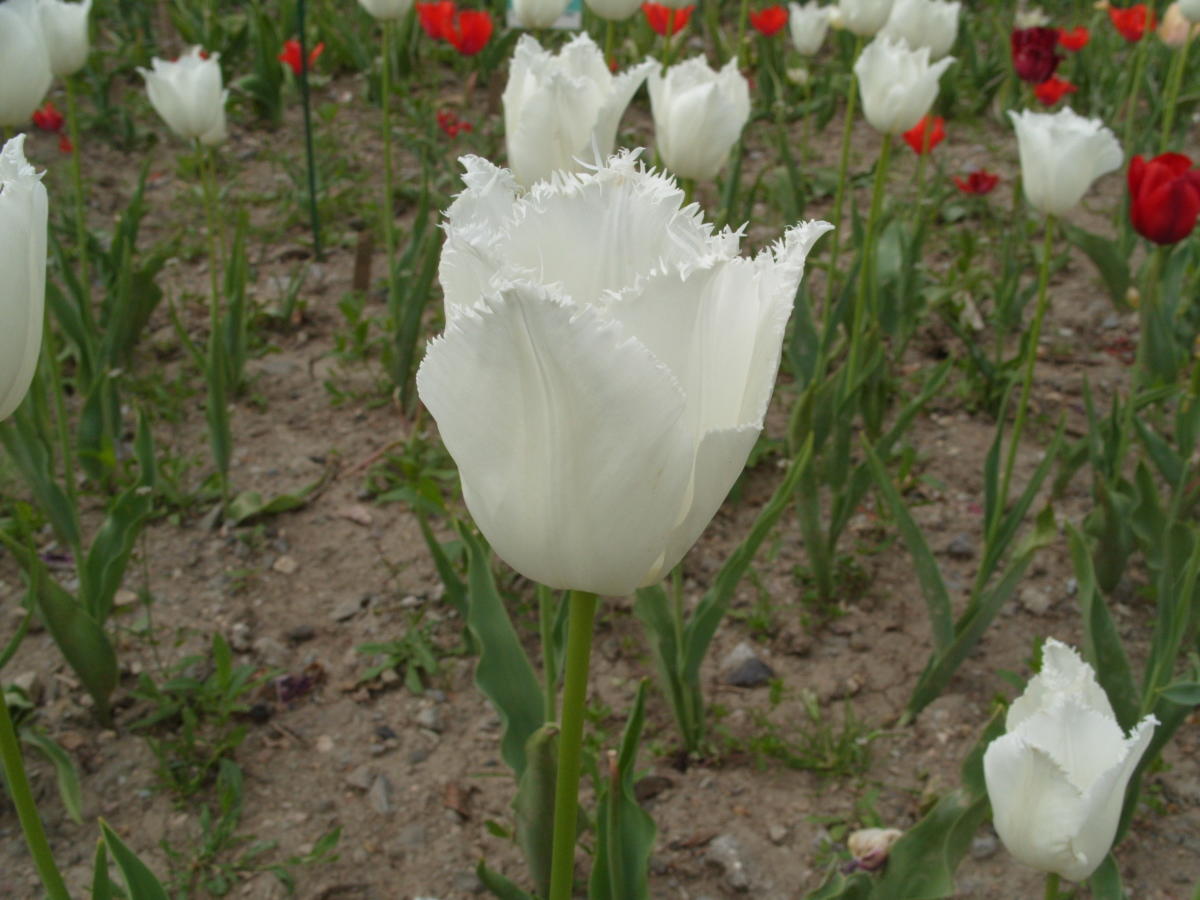
Feed the faded tulips with potassium-phosphorus fertilizer; remove the ovaries so that they do not take away the nutrition of the bulbs; if there are stems, do not cut them; water the plants for another two weeks after the flowers wither, then gradually reduce the watering, and when the leaves turn yellow and wither, dig out the bulbs. As you can see, the care of tulips after flowering is not difficult.
When to Dig Up
Novice flower growers sometimes make the mistake of leaving tulip bulbs in the ground for the entire summer. In fact, this can only be done with red varieties, and even then not with all. The fact is that in the tulips left in the ground, the flowers become smaller, and the stems become thinner and shorter. This happens because the mother bulb goes deeper into the ground with the appearance of babies, pushing the babies closer to the surface, and the next year we get the flowers of babies, and not a large mother bulb that has buried itself in the ground. Therefore, when the leaves of the tulips begin to dry naturally, and the end of the stem is easily wrapped around your finger, it’s time to dig out the bulbs. It is better to do this with a bayonet shovel, pushing the ground deeper than the bulbs sit.
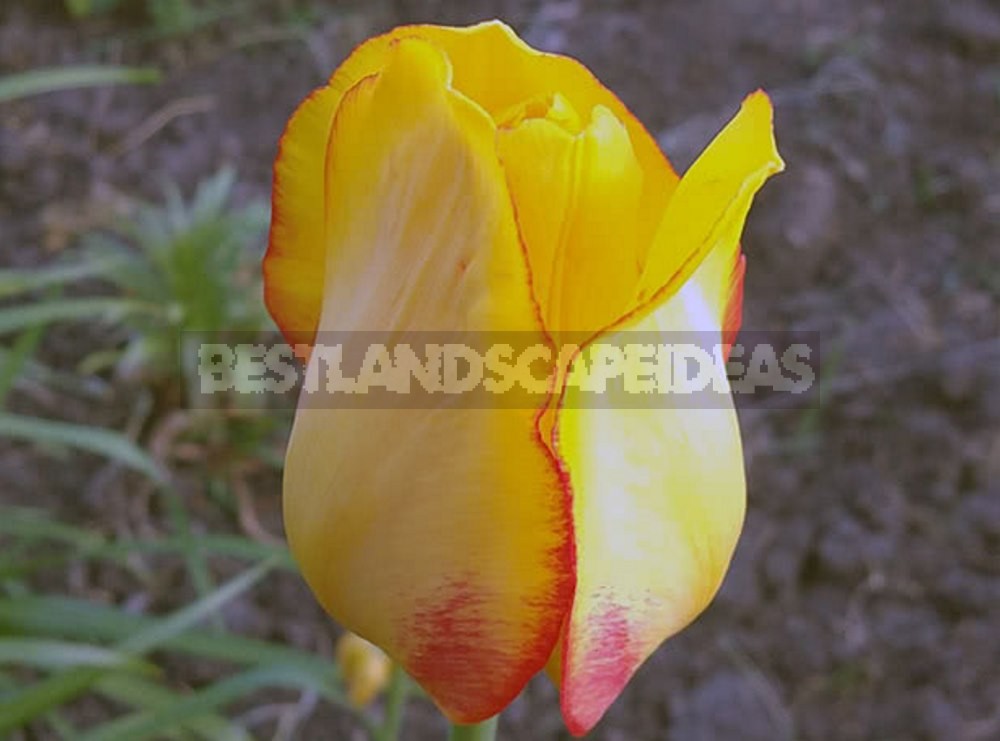
Storage of Tulip Bulbs
Excavated bulbs should be disinfected from diseases and pests before drying. Rinse them in running water and soak them for half an hour in a three-to four-percent carbofos cocktail or dip the bulbs for ten minutes in hot (50°C – 122°F) water. Then arrange the bulbs in a single layer in a shaded, dry room with good ventilation and a temperature of 25-30°C (77-86°F) and dry them there for 3-5 days before storing the tulip bulbs.
How to Store Tulips Before Planting
Clean the bulbs from old scales and roots, from the remnants of the earth, sort by size, separate the easily departing children. Spread the tulip bulbs in a single layer in the lattice boxes and place them in the shed or in the attic. Do not cover the bulbs: they emit ethylene, which can kill small bulbs. Provide stored bulbs with good ventilation and low ambient light.
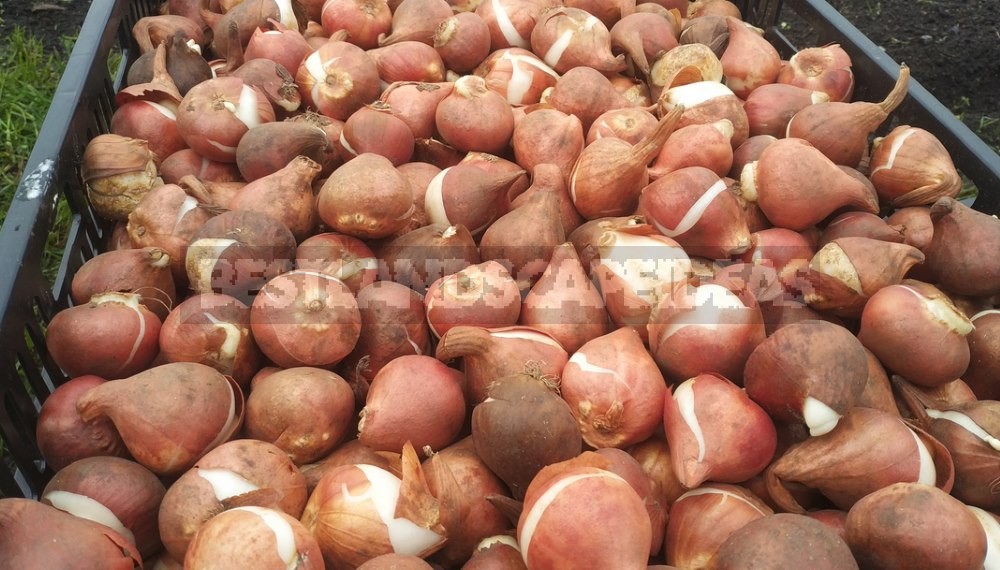
The optimal storage temperature is 20°C (68°F) until September, later it is desirable to lower the temperature to 17°C (62.6°F) and store the bulbs at this temperature until they are planted in the open ground.
At least once a week, feel and inspect the bulbs to detect those affected by pests or diseases, mercilessly discard soft bulbs or bulbs with white or yellowish spots, as this may be a symptom of a putrid infection. Before the autumn planting, treat the bulbs of tulips with a mixture of potassium permanganate again to avoid unpleasant surprises in the spring.
Best Varieties with Photos and Names
Most of the cultivated tulips belong to the species Tulipa gesneriana, there are also wild species Tulipa sylvestris (forest tulip), Tulipa biebersteiniana( Bieberstein tulip), Tulipa biflora( two-flowered tulip), as well as Tulipa greigii, Tulipa pubescens, Tulipa eichleri, etc.
In November 1981, Dutch flower growers compiled a new (last) classification and register of ten thousand varieties of tulips, which divide the existing varieties into four groups and fifteen classes. This classification is accepted by all flower growers in the world.
The first group. Early-flowering tulips First class
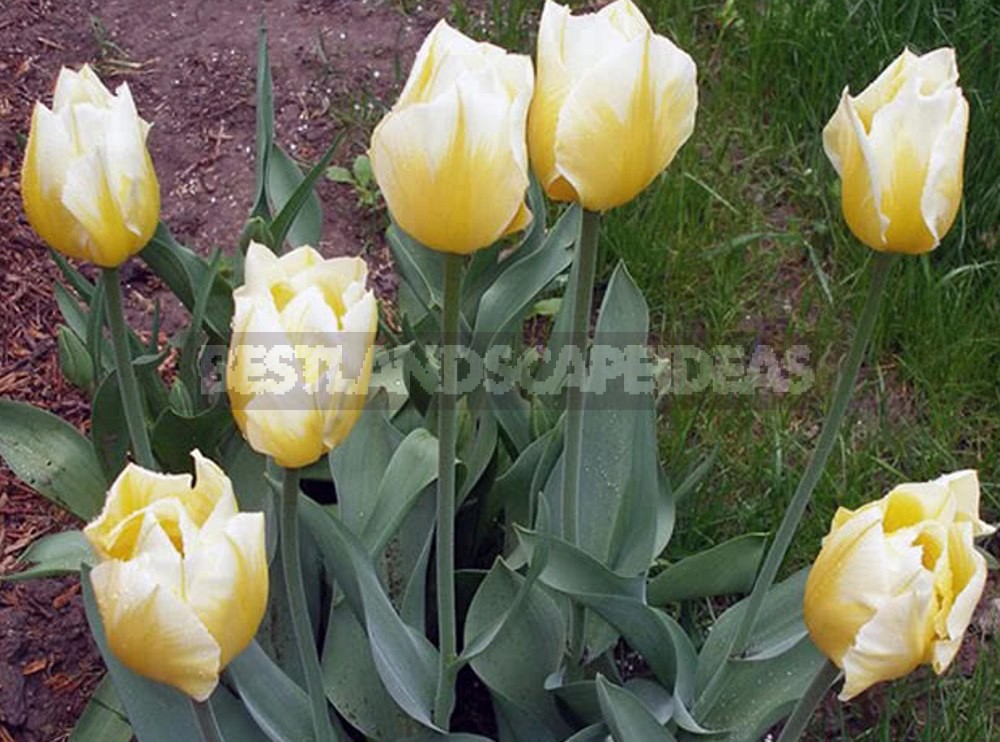
First class. Simple early tulips: low, very stable, peduncles (25-40 cm – 10-16 inch), the shape of the flower is goblet-shaped and cup-shaped, the color is red or yellow (Golden Olga, Demeter, Golden Harvest).
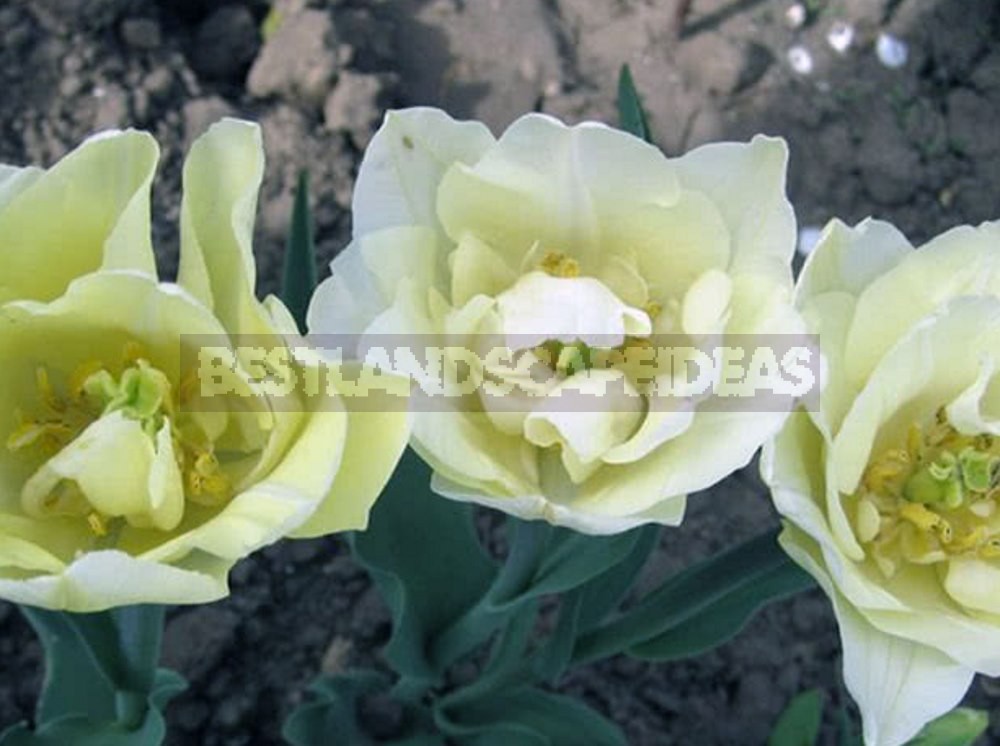
Second class. Double early tulips: height 25-35 cm (10-14 inch), double flowers of warm colors (red, yellow), when fully opened, reach 10 cm (4 inch) in diameter, bloom for a very long time (varieties Shunord, Electra, Madame Testu).
The second group. Medium-flowering tulips

Third grade. Triumph tulips: peduncles 40-70 cm (16-28 inch), large, goblet-shaped flowers, various colors, from snow-white to dark purple (varieties Golden Eddy, Crater, Snowstar).
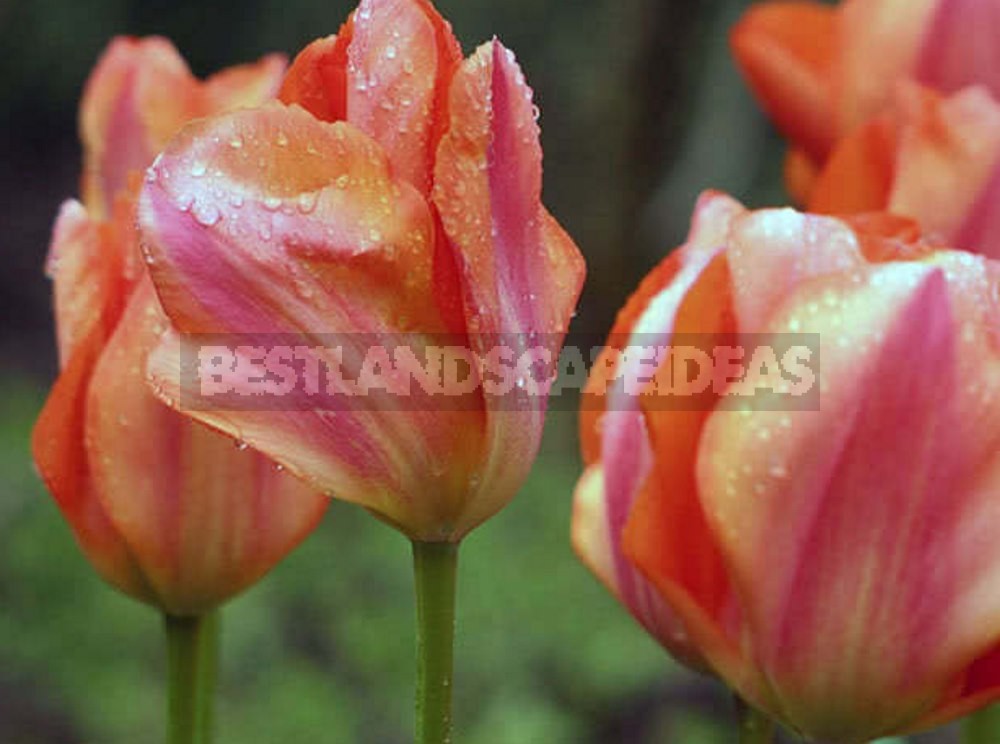
Fourth grade. Darwin’s tulips: peduncles 60-80 cm (24-32 inch) in height, flowers with a diameter of 10 cm (4 inch) or more, have a rich, pure red color, although there are varieties of other shades of red, even two-tone. Resistant to spring frosts and variegation virus (varieties Apeldorn, Big Chief, Vivex).
The third group. Late-flowering tulips

Fifth grade. Simple late tulips: powerful, tall (60-75 cm – 24-30 inch), large goblet-shaped flowers with a square base and obtuse petals. The colors range from white to black, from light pink to burgundy, there are two-color varieties that reproduce perfectly (Dillenburg, Georgette, Bacchus varieties).
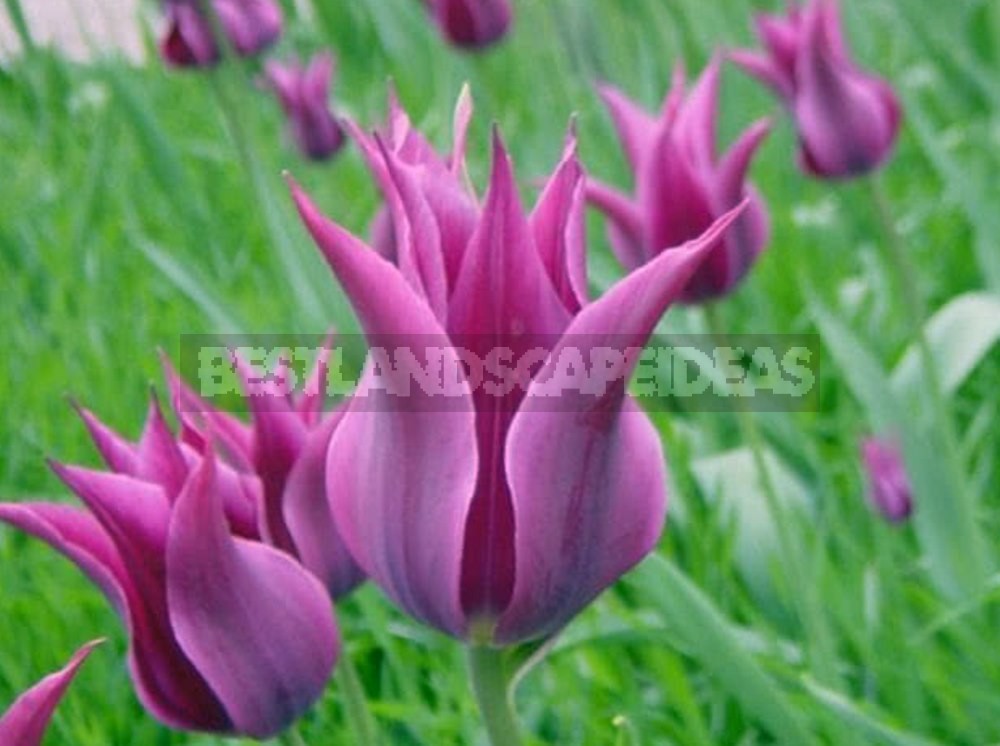
Sixth grade. Lily-colored tulips: elegant goblet-shaped flowers with bent pointed petals, the height of the arrow is 50-60 cm (20-24 inch), the color is diverse (varieties White Triumphator, Red Shine, Gisella).
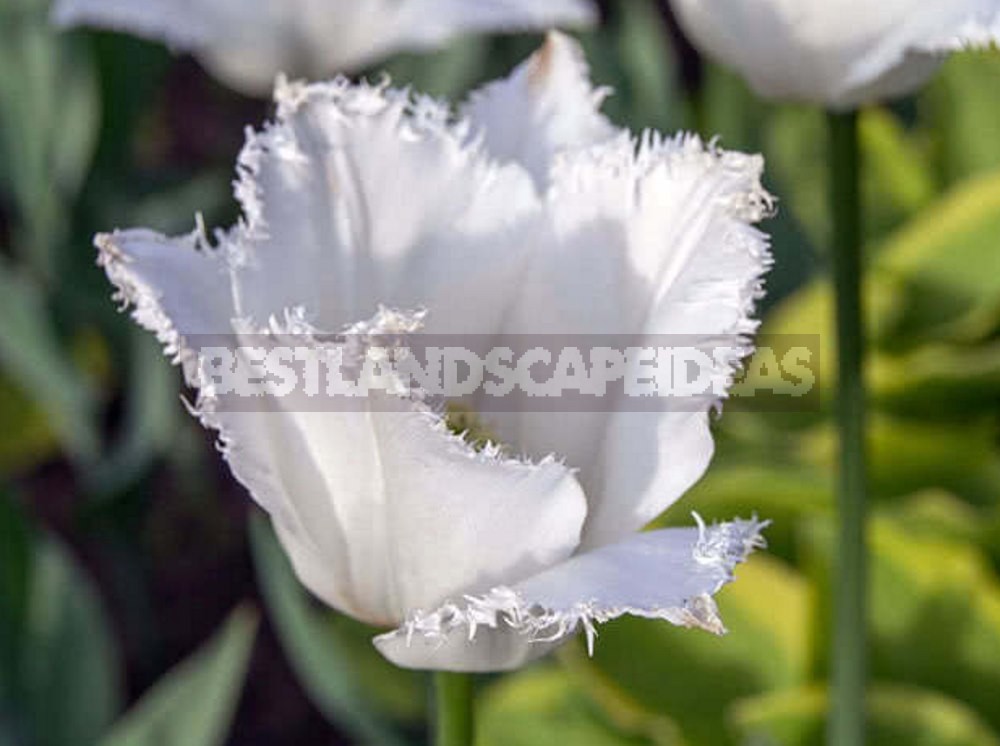
Seventh grade. Fringed tulips: tulips of various origins with one characteristic – a needle-like fringe on the edge of the petals. Height – 50-80 cm (20-32 inch), color from white to dark chocolate and purple. The size and shape of the flower depends on the species that was used to breed the variety (varieties Maya, Exotic, Burgundy Lace).

Eighth grade. Green-flowered tulips: in these tulips, the backs of the petals are green throughout the flowering period, which is currently on trend. Height from 30 cm to 60 cm (12-24 inch). The flowers are 6-10 cm (2.4-4 inch) long, the leaves are usually narrow (varieties Hollywood, Samurai, Artist).

Ninth grade. Rembrandt’s tulips: a small class that combines variegated varieties of tulips. The flowers are goblet-shaped, rather large, 7-9 cm (2.8-3.6 inch) long, with spots or streaks on a red, white or yellow background. The height of the peduncle is 40-70 cm (16-28 inch) (varieties Montgomery, Black Boy, Pierrette).
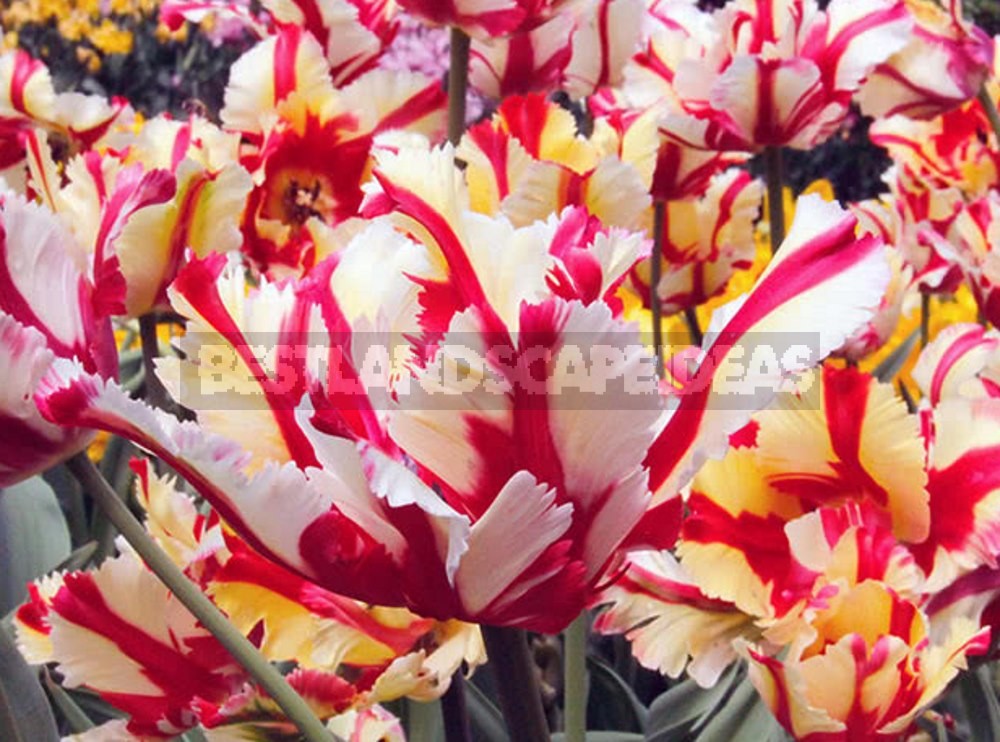
Tenth grade. Parrot tulips: the most exotic of all. Petals, deeply “cut” at the edges, resembling a bird’s wing. When opened, the flower sometimes reaches 20 cm (8 inch) in diameter. Color from white to black and red, height – 40-65 cm (16-26 inch) (varieties Black Parrot, Discovery, Fantasy).

Eleventh grade. Double late tulips: dense double peony-shaped flowers, peduncles 45-60 cm (18-24 inch) high, much larger than double tulips and bloom later than them. The color is varied, there are two-color varieties (popular varieties Eros, Livingston, Nice).
The fourth group. Pedigreed and botanical

The twelfth grade. Kaufman tulips: bloom earlier than all tulips, low (15-25 cm – 6-10 inch), the flowers are large, elongated, and when they open – star-shaped. The coloration is varied, but most often the Kaufman tulips are two-colored. The leaves of this class are very noticeable: they are distinguished by purple specks or stripes (varieties of Lady Rose Orange Boy, Diamond, Crown).
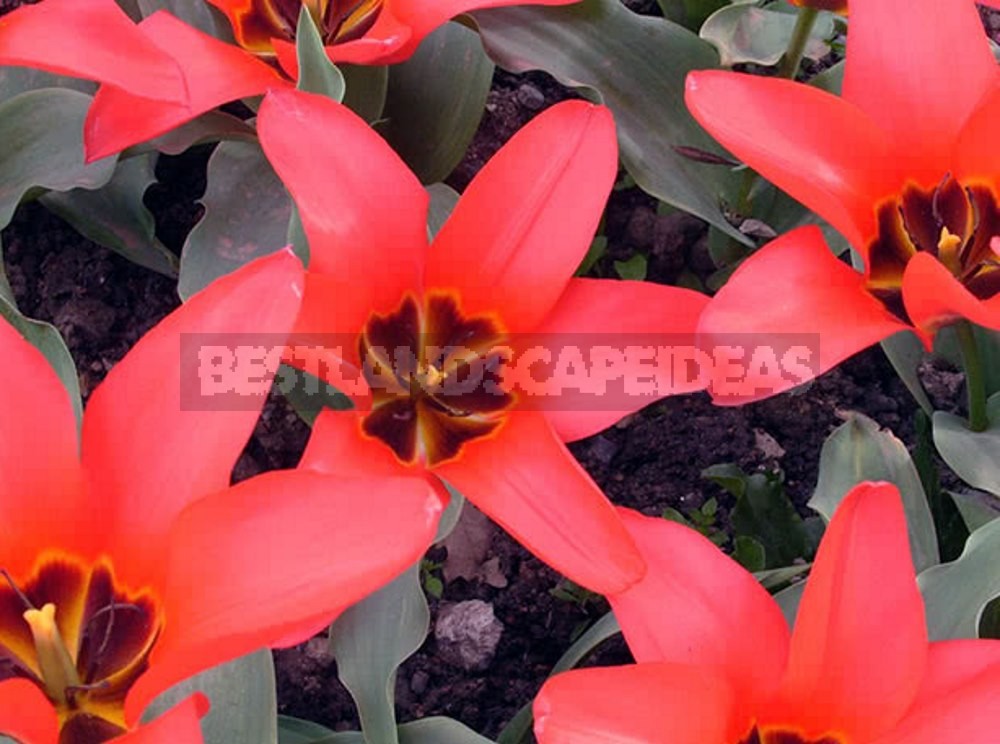
The thirteenth grade. Foster’s tulips: these tulips are larger, cup-shaped or goblet-shaped, strongly elongated-flowers up to 15 cm (6 inch) in length with a peduncle height of only 30-50 cm (12-20 inch). The color is in bright red and red-orange tones, there are varieties of yellow and pink. The leaves of tulips of this class are fleshy, slightly wavy, sometimes marked with purple strokes (varieties of Patience, Zombie, Copenhagen).
The fourteenth grade. Greig’s tulips: these are low-growing tulips (20-30 cm – 8-12 inch) with large flowers on a wide base, the petals are slightly bent back. They are colored in shades of red, there are two-color forms, the leaves are speckled (varieties Zampa, Yellow Down, Pleasant).
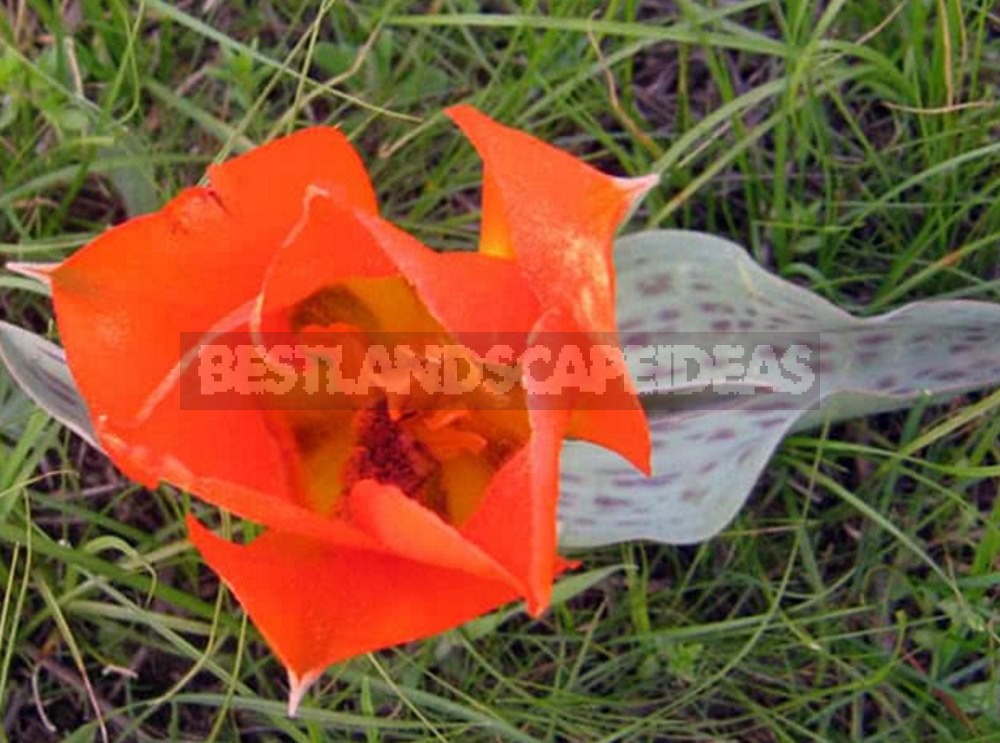
The fifteenth grade. Botanical tulips: all wild-growing types of tulips, as a rule, are low-growing, early-flowering, color is diverse, there are multi-flowered species (Schrenck’s tulip, Gesner’s tulip).

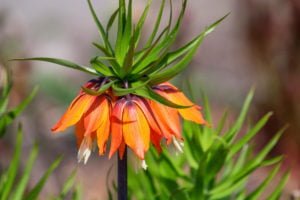
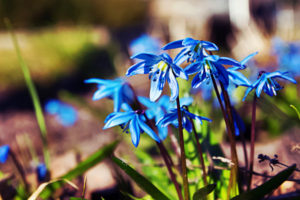

Leave a Reply